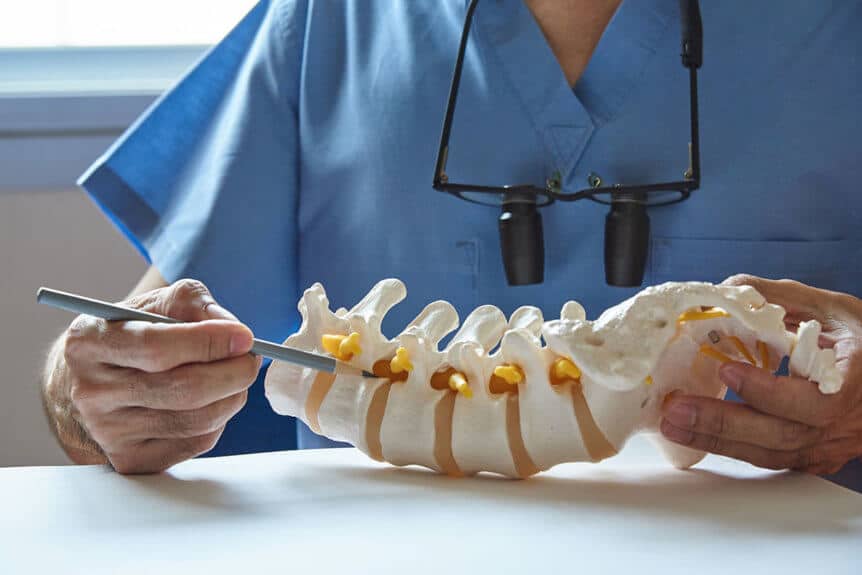
How Spinal Cord Stimulation Can Fight Chronic Pain
Share this Post
Spinal cord stimulation can treat chronic pain in the back, leg, or arm that is not responsive to more conservative treatment methods. It can also help to reduce reliance on opioid pain medications and improve functionality. Here is what to expect.
What Is a Spinal Cord Stimulator?
A spinal cord stimulator is a small device that resembles a pacemaker. Surgically placed under the skin, it uses wires to deliver a mild electric current from a pulse generator in the device to the nerves of the spinal cord. The current modifies the pain signals in the nerves and blocks them from reaching your brain.
Although spinal cord stimulation does not treat the source of the pain, it provides relief from the sensation of pain. Depending on the chosen setting, as well as your own unique brain chemistry, you may feel a tingling sensation instead.
How Much Pain Relief Can I Expect?
The goal for pain relief by spinal cord stimulation is a 50-70% reduction in pain levels. However, some people get significant benefits from even a small amount of pain relief, while others experience a near-total level of pain relief. Spinal cord stimulation is often used in tandem with other treatments, such as physical therapy, to further improve results.
Pain is highly individualized, so that means spinal cord stimulation may not be the best choice for everyone. Some people may not experience any relief, while some are unable to tolerate the tingling sensation that may be experienced. For these reasons, we may suggest a trial run for one week. If you decide that spinal cord stimulation is not right for you, we can remove the trial wires without damaging your nerves or spinal cord.
Am I a Candidate for Spinal Cord Stimulation?
Our highly-skilled physicians will assess your current physical condition, pain history, medications, relevant previous health conditions and surgeries, and other factors to make a determination of eligibility for spinal cord stimulation. In general, candidates for spinal cord stimulation have had debilitating chronic pain in the lower back, arm, or leg for at least three months that has not responded to more conservative treatments and is not likely to benefit from surgery. Many people who choose spinal cord stimulation have already undergone one or more spinal surgeries.
You should not have spinal cord stimulation if you have untreated depression, or drug addiction, or any medical condition that would preclude the implantation process. Spinal cord stimulation typically works best in the early stages of chronic pain, but it has been successfully used in patients who have suffered for years.
Life With a Spinal Cord Stimulator
Your spinal cord stimulator comes with a handheld programmer that lets you make various adjustments. We will set different programs and teach you how to use the programmer. We may tweak the preset programs at follow-up visits to maximize your relief.
You may notice a difference in stimulation levels when you are sitting versus standing. This is normal, as the spread of electricity changes when you change positions.
The stimulator will not be damaged by common devices such as cell phones, microwaves, or anti-theft sensors. However, it will be detected when you go through airport security. Always carry your Implanted Device card to show the TSA (Transportation Security Administration) officials. Turn off your system as a precaution when passing through any security checkpoint to avoid a sudden increase or decrease in stimulation.
Different stimulators have different restrictions regarding MRIs, ultrasounds, cardiac pacemakers, defibrillators, and other medical equipment. Familiarize yourself with your device and contact your physician if you have any questions or concerns. Do not seek chiropractic care without your doctor’s approval, as manipulations could cause the wires to move.
Ready to Get Started?
If you are ready for a new, fully integrated approach to health and wellness, contact CORE Medical & Wellness today at 888-521-0688 to learn more or schedule your appointment!
Dr. Richard Kang is double board certified in anesthesiology and pain medicine, and he completed an interventional pain medicine fellowship at the prestigious New York Presbyterian Hospital / Columbia University – College of Physicians and Surgeons. Read his full bio here.
